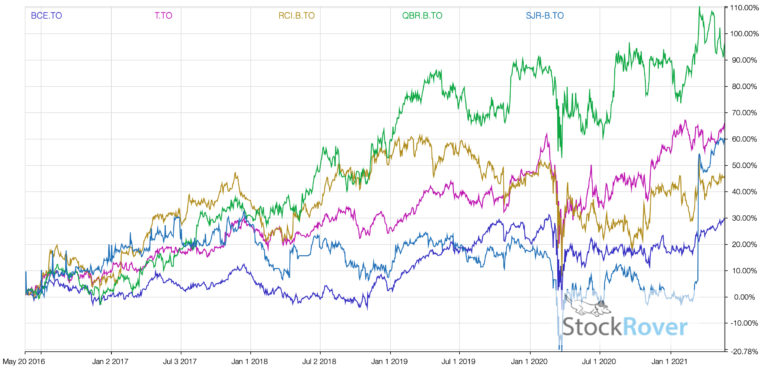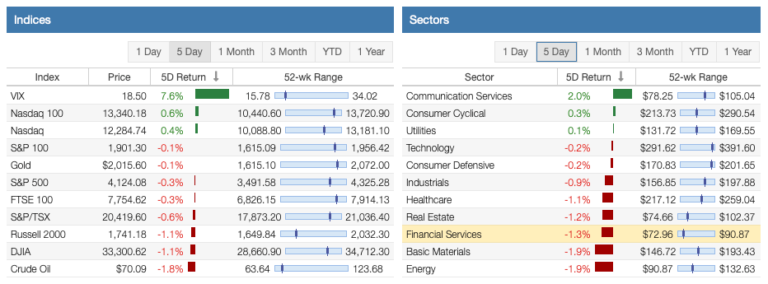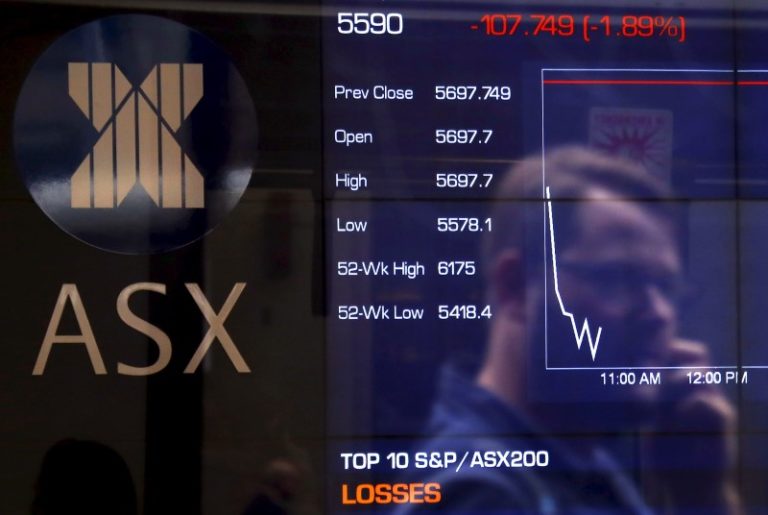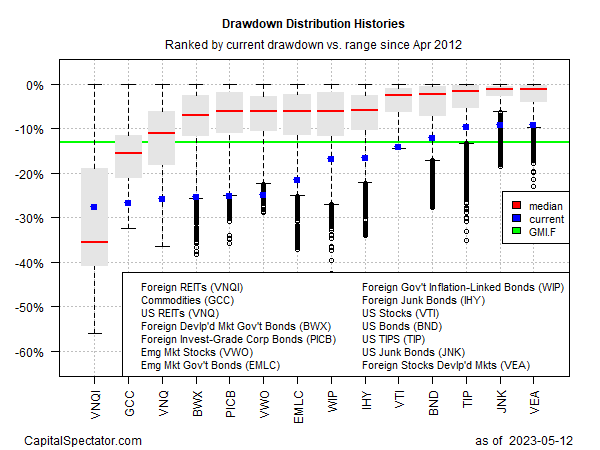
Smart Is Not Enough – Week In Review
Smart Is Not Enough
The year 2022 has been a difficult time for many investors. What seemed like a genius move in 2020 – 2021 has not worked in 2022 for many investors. It is not enough to be smart in investing; other characteristics like temperament, patience, and consistency are more important.

For instance, according to data from StockRover*, Technology and Consumer Cyclical stocks are the worst-performing sectors year-to-date (YTD), while they were the best performing sectors in 2020 – 2021. On the other hand, the Energy sector struggled in 2020 but is by far the best performing sector in 2022. An intelligent investor in 2020 – 2021 probably realizes they are not so bright in 2022 if they are sticking to the same high price-to-earnings (P/E) ratio strategy. One must go no further than the WallStreetBets board, where cloud and other tech stocks were the most discussed. Today, the top of the list is very different.

The top-performing stocks YTD are mostly energy stocks in the S&P 500 Index. The number one stock is Occidental Petroleum (OXY). It was not that long ago when Occidental cut the dividend twice because it was loaded with debt after acquiring Andarko Petroleum, and oil prices plunged. Occidental Petroleum is the No. 7 stock on WallStreetBets, much different than 2020 – 2021. The so-called smart money was not investing in Occidental in 2020 when the stock could have been bought at a range of $10 – $15 per share. The share price is $56.15 at close this past Friday.

The top-performing stock in the Dow 30 is Chevron (CVX). Dividend Power identified Chevron in early-2021 as an undervalued opportunity with a 5.5% yield. Today, Chevron is the number 39 most discussed stock on WallStreetBets. Again, smart money could have bought shares at $55 to $80 per share for much of 2020. The stock price is $158.65 at close this past Friday.

So, if being smart is not enough, what characteristics are needed? I would argue more important characteristics are temperament, knowledge and learning, and consistency. I have written about traits of a successful investor before, and consistency can be thought of as structure and discipline.
Temperament
I have written about temperament versus intellect in the context of investing before. Warren Buffett has stated,
The most important quality for an investor is temperament, not intellect… You need a temperament that neither derives great pleasure from being with the crowd or against the crowd.
In an interview, he and Charlie Munger, his business partner, have emphasized this point.
Munger: We’ve learned how to outsmart people who are clearly smarter [than we are.]
Buffett: Temperament is more important than IQ. You need reasonable intelligence, but you absolutely have to have the right temperament. Otherwise, something will snap you.
Temperament is more about not being emotional during investing and realizing you are not more intelligent than everyone else. For example, the hedge fund Long-Term Capital Management had several smart people, including Nobel Prize winners. Yet, the fund lost $4.6 billion in under four months during the 1997 – 1998 global financial crisis. The problem was too much leverage and risk.
Today, hedge funds are staffed with some really smart people. Funds hire MBAs and Ph.Ds. with degrees in aerospace engineering, computer science, physics, and more. They employ mathematical models and faster computers than retail investors have access to. However, in some years, they struggle to beat the S&P 500 Index.
Investors recognizing that they are not smart enough to outperform the broader market is probably one of the best realizations they can achieve.
Knowledge and Learning
An investor must understand that knowledge and learning are part of knowing that they are not smart enough to beat the market year-in and year-out. Munger and Buffett have commented on that point too.
Munger: The other big secret is that we’re good at lifelong learning. Warren is better in his 70s and 80s, in many ways, than he was when he was younger. If you keep learning all the time, you have a wonderful advantage.
Buffett: And we have a wonderful group of friends, from whom we can learn a lot.
Smart investors learn from their mistakes and apply the lessons learned for the next investment.
Consistency
An investor may not be smart enough to beat the market independently. However, they can apply structure and discipline to their investing. If they consistently do this, an investor can be successful over time. Whether you are a dividend growth investor, an index investor, or both, consistency over time is a smart move.
Affiliate
Dividend Power has partnered with Sure Dividend, one of the best newsletters for dividend stock investing. The newsletter comes out monthly and highlights their top 10 picks. A lot of effort goes into analyzing hundreds of stocks, doing much of the work for you. They have over 9,000 subscribers, and it grows every month.
Sign up for the Sure Dividend Newsletter*. You can also use the Sure Dividend coupon code DP41off. The regular price for Sure Dividend Newsletter* is $199 per year and the reduced price through this offer is $158 per year. There is a 7-day free trial and refund grace period as well. So, there is no risk.
If you are interested in higher-yielding stocks from the Sure Retirement Newsletter*, the same coupon code, DP41off, gives ~25% or $41 off. The regular price of the Sure Retirement Newsletter* is $199 and the reduced price through this offer is $158 per year.
If you are interested in buying and holding stocks with a rising income from the Sure Passive Income Newsletter*, the same coupon code, DP41off, gives ~25% or $41 off. The regular price of the Sure Passive Income Newsletter* is $199 and the reduced price through this offer is $158 per year.
The Stock of the Week
Today I highlight Home Depot (HD). The retailer is one of two large hardware and home improvement retailers in the US. Its main competitor is Lowe’s (LOWE). The stock price is down about (-21.9%) YTD putting it in bear market territory. Home Depot’s dividend has been raised 13 consecutive years, making it a Dividend Contender. The forward payout ratio is conservative at ~43%. The dividend growth rate has been outstanding at 19.1% CAGR for the past 5-years and 20.3% CAGR for the past decade. The stock is trading below its average P/E ratio in the past decade of 22.2X to 24.1X. Investors should look at Home Depot now.
The screenshot below is from Stock Rover*.

Dividend Increases and Reinstatements
Search for a stock in the list of dividend increases and reinstatements. This list is updated weekly. In addition, you can search for your stocks by company name, ticker, and date.
Dividend Cuts and Suspensions List
The dividend cuts and suspensions list was most recently updated at the end of January 2022. As a result, the number of companies on the list has risen to 543. Thus, well over 10% of companies that pay dividends have cut or suspended them since the start of the COVID-19 pandemic. The list is updated monthly.
One new addition indicated that companies are experiencing solid profits and cash flow in January.
The new addition was Compass Diversified (CODI).
Market Indices
03/05/22
Dow Jones Industrial Averages (DJIA): 33,615 (-1.30%)
NASDAQ: 13,313 (-2.78%)
S&P 500: 4,329 (-1.27%)
Market Valuation
The S&P 500 is trading at a price-to-earnings ratio of 24.7X, and the Schiller P/E Ratio is about 35.4X. These two metrics were up in the past week. Note that the long-term means of these two ratios are 16.0X and 16.9X, respectively.
The market is still overvalued despite the recent market correction. Earnings multiples more than 30X are overvalued based on historical data.
S&P 500 PE Ratio History

Shiller PE Ratio History

Stock Market Volatility – CBOE VIX
This past week, the CBOE VIX measuring volatility was up 4.5 points to 31.98. The long-term average is approximately 19 to 20. The CBOE VIX measures the stock market’s expectation of volatility based on S&P 500 index options. It is commonly referred to as the fear index.

Yield Curve
The two yield curves shown here are the 10-year US Treasury Bond minus the 3-month US Treasury Bill from the NY York Fed and the 10-year US Treasury Bond minus the 2-year US Treasury Bond from the St. Louis Fed.
Inversion of the yield curve has been increasingly viewed as a leading indicator of recessions about two to six quarters ahead, according to the NY Fed. The higher the spread between the two interest rates, the higher the probability of a recession.


Economic News
The US Energy Information Administration reported that US commercial crude oil stockpiles decreased by 2.6M barrels to 413.4M barrels (12% below the five-year average) for the week ending February 25th. Crude oil refinery inputs averaged 15.4M barrels per day, an increase of 153K barrels per day compared to the previous week’s average. Gasoline inventories decreased by 0.5M barrels (1% below the five-year average). Refineries operated at 87.7% of their operable capacity, as gasoline production increased an average of 9.3M barrels per day. Crude oil imports came in at 5.8M barrels per day, a decrease of 1.1M barrels per day compared to the previous week.
The Labor Department reported a decrease in initial jobless claims for the week ending February 26th. The seasonally adjusted initial claims were reported at 215,000, which decreased 18,000 from the previous week’s upwardly revised level. The four-week moving average, which smooths out volatility was 230,500, a decrease of 6,000 from the previous week’s revised average. Michigan led with a (-9,200) drop in initial claims, followed California (-4,673), and Florida (-2,388). Both Massachusetts (+3,137) and Rhode Island (+1,039) saw increases.
The US Bureau of Labor Statistics reported 678,000 jobs were added in February, as the unemployment rate edged down to 3.8%, with 6.3M unemployed. February 2020’s pre-pandemic reading was 3.5%, with 5.7M unemployed. The data pre-dates Russia’s invasion of Ukraine. Impacting the headline number was leisure and hospitality (+179K), professional and business services (+95K), health care(+64K), and construction (+60K). Gains were also reported in transportation and warehousing (+48K), retailers (+37K), and manufacturing (+36K). December’s jobs report was revised up (+78K), and January (+14K) for a combined 92K additional jobs.
Thanks for reading Smart Is Not Enough – Week in Review!
Here are my recommendations:
If you are unsure how to invest in dividend stocks or are just getting started with dividend investing. Please look at my Review of the Simply Investing Report. I also provide a review of the Simply Investing Course. Note that I am an affiliate of Simply Investing.
If you are interested in an excellent resource for DIY dividend growth investors. I suggest reading my Review of The Sure Dividend Newsletter. Note that I am an affiliate of Sure Dividend.
If you want a leading investment research and portfolio management platform with all the fundamental metrics, screens, and analysis tools you need. Read my Review of Stock Rover. Note that I am an affiliate of Stock Rover.
If you would like notifications about when my new articles are published, please sign up for my free weekly e-mail. You will receive a free spreadsheet of the Dividend Kings! You will also join thousands of other readers each month!
*This post contains affiliate links meaning that I earn a commission for any purchases that you make at the Affiliates website through these links. This will not incur additional costs for you. Please read my disclosure for more information.
Published at Sun, 06 Mar 2022 04:00:00 -0800




